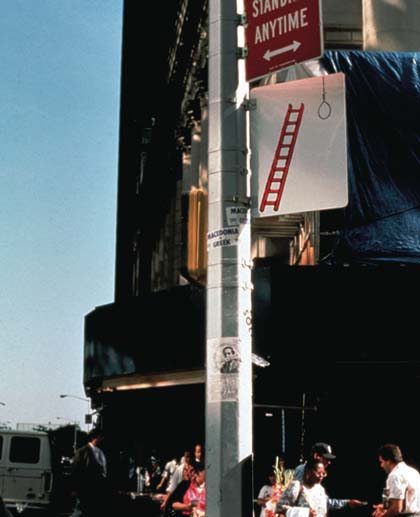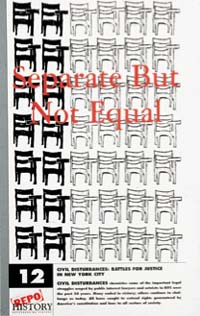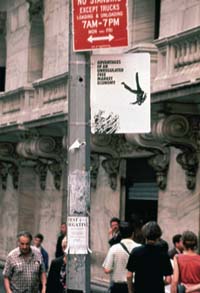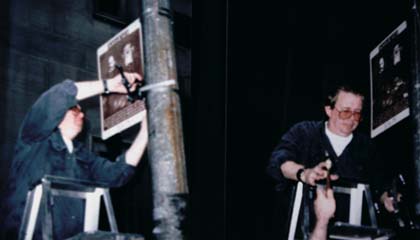Mysteries of the Creative Class, or, I Have Seen The Enemy and They Is Us
Artists and other ‘creative’ professionals are increasingly willing pawns in the State-backed gentrification games of developers and corporations. But can those that wish to challenge the underlying brutalities of ‘culture-led regeneration’ turn their creative powers against it? Gregory Sholette on New York artists’ collective REPOhistory and their fight to re-write the story of urban renewal in Manhattan
 > REPOhistory, ‘Lower Manhattan Sign Project’, Stephen Duncomb, Leisler's Rebellion, 1992
> REPOhistory, ‘Lower Manhattan Sign Project’, Stephen Duncomb, Leisler's Rebellion, 1992
A painting of a smartly clad, long necked and sophisticated trio of young white people conversing over a glass of wine fills a full page of the Sunday New York Times. Done in a 1930s Art Deco style, the advertisement is captioned ‘An Oasis In Times Square.’ This, the copy explains, is a place where the traveller, weary from business, can discover tranquility amidst energy and ‘A new level of self-indulgence.’ It was the year 1999 when, with retrograde panache, the Hong Leong Group launched ist flagship hotel in New York, the Millennium Premier. Even then I sensed the arrival of something new, a shift in tactics in the decade-old ‘upclassing’ of the city. I also knew something troubling about the hotel’s recent past that made my hunch even more compelling.
 > REPOhistory, ‘Civil Disturbances’, Laurie Ourlicht's street sign detailing the historic Brown Vs the Board of Education desegregation law suit brought by the National Association for the Advancement of Colored People
> REPOhistory, ‘Civil Disturbances’, Laurie Ourlicht's street sign detailing the historic Brown Vs the Board of Education desegregation law suit brought by the National Association for the Advancement of Colored People
A veteran of anti-gentrification activism on the city’s Lower East Side some 20 years earlier, I still recall the clumsy call for ‘pioneers’ to brave the city’s harsh urban frontiers. But by the late 1990s this type of gambit had largely played itself out, at least in Manhattan. Already most of the island was well on its way to full blown gentrification and what was left of the poor and working class largely scattered by force or rising rents in the wake of reverse white flight that began in the 1980s. However, this late ’90s wave of gentry wanted nothing to do with leaking pipes or chasing away crack-heads from street corners, and under no circumstances would they wear overalls. Yet the hotel’s curiously retro illustration also avoided references to the fevered, technogiddiness of those blissful, pre-crash ‘90s. Instead, the unknown artist lovingly invoked the modernist conceit of the machine age some 60 years prior. Nor was it camp, for the irony was too far adrift from any rhetorical moorings to signal ‘spoof’. Instead, like an arcane plot out of a Philip K Dick novel, the very visage of the city I knew was beingtransmuted from lead to gold. The more I looked, the more I saw. Quaint Cafés replaced actual coffee shops. Futuristic bars and art galleries took over food processing and light industrial shops. An ersatz cosmopolitanism was everywhere and the Millennium was a part of this larger whole that involved wiping clean not merely the physical traces of the past, but its memories. What filled up the ensuing breach were artful surrogates and clever replicas of a city that no one had ever lived in but that nevertheless looked strangely familiar. Certainly it is easier to see this in retrospect, but the Millennium campaign signaled the start of an entirely new era in the administration of free market urban renewal. More abstract, more inspired, more creative. The question I wanted to answer most, then and now, is whose minds the hotel chain’s marketers hoped to, well, gentrify, and what ghosts they sought to keep at bay?
It was the artists’ collective known as REPOhistory that provided the key to unlocking this mystery, but its startling solution, like Poe’s purloined letter, turns out to have been right in front of me all along.
DEMOLITION IN HELL’S KITCHEN
Located on West 44th Street, the Millennium Premier Hotel stands in a once largely Irish and working class neighborhood formerly known as Hell’s Kitchen but re-christened with the sanitary-sounding moniker ‘Clinton’ by real estate speculators in the 1980s. The Times Square from whose implied stresses it claims to offer an ‘oasis’ is no longer the porn playground of the fiscal crisis ‘70s. It has been rehabilitated: safe for families, safe for business, efficiently emptied of homeless people and sundry other uninvited. In May of 1998, however, a metal street sign appears outside the Millennium. The sign is flagged off of a lamppost, meters away from the hotel’s tastefully subdued, black marble façade. Mounted low enough for passersby to read, its text begins portentously:
What is now the Millennium Broadway Hotel used to be the site of 4 buildings including an SRO hotel that provided badly needed housing for poor New Yorkers...
Artist and architect William Menking designed the plaque to look like a busy montage of newspaper clippings. The story of the Hotel’s less than tranquil past continues in bold type:
In 1984, New York City passed a moratorium on the alteration of hotels for the poor. Hours before the moratorium was to go into effect, developer Harry Macklowe had the 4 buildings demolished without obtaining demolition permits, and without turning off water and gas lines into the buildings. NYC officials declared, ‘It is only a matter of sheer luck that there was no gas explosion.’ Attempts to bring criminal charges against Macklowe for these actions were not successful. Macklowe built a luxury hotel on the site, then lost it to the current owners. The demolition of hotels for the poor during the 1970’s and 1980’s added to the city’s growing homeless population. While streets of the ‘new’ Times Square seem paved with gold – for many they have literally become a home.
 > REPOhistory, ‘Lower Manhattan Sign Project’, Jim Costanzo, Benefits of a Free Market Economy. Outside the NY Stock Exchange building on Wall Street, New York, 1992
> REPOhistory, ‘Lower Manhattan Sign Project’, Jim Costanzo, Benefits of a Free Market Economy. Outside the NY Stock Exchange building on Wall Street, New York, 1992
Like the materialisation of an army of Dickensian apparitions, the Millennium/Macklowe sign was one of 20 temporary historical markers specifically sited around New York that made up the public art project ‘Civil Disturbances: Battles for Justice in New York City’. Sponsored by New York Lawyers for the Public Interest (NYLPI) and produced by the art and activist group REPOhistory, ist aim was to publicly landmark legal cases in which civil rights were extended to disenfranchised peoples. The content of the signs ranged from the famous Brown Vs the Board of Education desegregation case to the first woman firefighter sworn into service in NYC. Others however, pointed to occasions when the law had failed to protect as promised and Menking’s sign was in this category. Initially, for a time the city tried to stop REPOhistory from installing ‘Civil Disturbances’. After weeks of legal manoeuvres however, the signs went up from spring of 1998 to late winter of 1999. Nevertheless, right from the start several signs vanished after installation. Menking’s was among them.
Responding to an inquiry the Millennium freely admitted having its staff confiscate the legally permitted artwork. They even returned it to the group. However, along with the returned sign came a letter threatening legal action if any attempt was made to reinstall it. The grounds? REPOhistory was amaging hotel business. It seems the return of an inopportune past can prove a powerful trigger revealing hidden ideological tendencies in what appears otherwise to be a purely market driven process of privatisation and gentrification. After considerable debate that internally split REPOhistory roughly along lines of activists versus artists, Menking’s sign was reinstalled, but now at a greater distance from the hotel. And despite further threats the sign stayed in place, the project’s permit ran its course, and neither side took legal action. It is five years on. Aside from this text and other scattered citations, Macklow’s ‘midnight demolition’ is forgotten along with those he cruelly displaced. At the tranquil oasis in old Hell’s Kitchen stylish guests still sip wine, discuss art, and continue to manufacture content for the information economy.
WINNERS AND LOSERS
All of this is familiar now. The 1990s affection for the 1920s and pre-crash 1930s, its weird merger of avant-garde aesthetics, high fashion, and post-Fordist management theory all dolled-up in a neo-modernist longing for limitless progress. So what if the occasional act of terror was, and remains indispensable to make it all seem real? Why dwell on conflict? If the creative class has supplanted the traditional labouring class in many places it has done so by greeting capital as potential equal, not as adversary. Winners are admired. Losers on the other hand are truly abject, lacking the aptitude to become exploiters themselves. Asserting a collective disarray, an enduring a-historicity, and a belief they have transcended labour/management antagonisms, creative workers think they can even avoid being exploited in the long run because their big, table-turning breakthrough is always just around the corner, always about to make that longedfor reservation at the swanky Millennium tower a reality.
Anyway, it’s 2004, and billionaires abound. According to Forbes’ recent survey they number a record 587. Still, it’s difficult not to notice a connection between this fact and the new economy with its deregulated markets, rampant privatisation, decaying worker protection and widening gap between rich and poor. Nor are the super-rich all petroleum refiners and armament producers. Many belong to the socalled creative class. Among those joining the ten figure income bracket include the rags to riches writer of Harry Potter stories, JK Rowling; Google creators Sergey Brin and Larry Page; and Gap clothing designer Michael Ying. So why am I still surprised when I walk down formerly forbidding streets to see such upscale consumption? Designer outlets, smart eateries, bars radiant with youthful crowds, and taxis shuttling celebrants to and fro. Block after block the scene resembles a single, unending cocktail party strung like carnival lights up and down the avenue. Between these cheerful stations other men and women, mostly in their forties and fifties, haunt the shadows gathering glass and metal recyclables from public waste bins. Certainly losers can’t harm you. But what about ghosts?
 > REPOhistorian Tom Klem installing Gregory Sholette's signs about JP Morgan for the ‘Lower Manhattan Sign Project’, 1992
> REPOhistorian Tom Klem installing Gregory Sholette's signs about JP Morgan for the ‘Lower Manhattan Sign Project’, 1992
I enter bar ‘X’. Its ambiance probably not much different from bars in the Millennium New York, or Millennium Shanghai, or Millennium London. I shout for a dry, gin Martini over the mechanised music. (A cartoon thought-bubble appears, ‘Am I the only person in here with a beard?’ ‘The only one over 40?’) My mind returns to REPOhistory and its altruistic necromancy some six years earlier. ‘If the enemy wins, not even the dead will be safe,’ Walter Benjamin once declared. Not safe from whom? Perhaps it was the noise and the alcohol, but a surprising correlation asserts itself. REPOhistory was part of the creative class. While its objectives were different, REPOhistory, like RTmark, the Yes Men, and similar artistic agitators made use of available technologies and rhetorical forms to reach the same erudite consumer-citizens this swanky bar hoped to attract. The Millennium had been correct all along: we were the competition. With a little toning down of its righteous antagonism REPOhistory could have even taken its place amongst the web designers, dressmakers, MTV producers and other content providers of the new, immaterial economy. And come to think of it, right before the group folded it was increasingly being asked to travel outside to this or that city or town and install public markers about the quaint olden times; the local barber shop, the saloon, the red-light district and parade grounds. I had indeed found the enemy: it was me.
Like forgotten letters in some dimly lit archive, those not immediately part of the radical shift in the means of production remain out of sight, out of mind, fleeing from demolitions, downsizings and sometimes rummaging for cans. Not that this zone of dark matter was not always present and surrounding the upwardly mobile types such as the Millennium crowd. What is new, however, is the way this far larger realm of unrealised potential can gain access to most of the means of expression deployed by the burgeoning consciousness industry – that ubiquitous spectacle essential to the maintenance of global capitalism. By the same token, the so called ‘insiders’ might, if circumstances permit, decide to cast their collective lot in with the losers and the ghosts. REPOhistory et al proves it can happen. Because even the new creative class with its 80-hour work week and multiple jobs has a fantasy, one half-remembered perhaps and a bit mad, yet still evident in times of stress and economic uncertainty. It goes like this: the bar tenders and the brass polishers and cooks, the laundresses and bell hops throw down their aprons and spatulas to join in mutinous celebration with artists, web designers and musicians. Raiding the wine cellar, they open up all 33 executive style conference rooms, set up a free health clinic in the lobby, transform the hotel into an autonomous broadcasting tower and party in a universe of creative dark matter.
I finish my drink and return home to wrap-up the essay I promised the fine, creative folks at Mute.
Gregory Sholette <gsholette AT verizon.net> is an artist and writer living in NYC. He was a charter member of Political Art Documentation and Distribution (PAD/D 1980-86) and of REPOhistory. The group officially disbanded in 2000 but their work is documented online at http://www.repohistory.org
Mute Books Orders
For Mute Books distribution contact Anagram Books
contact@anagrambooks.com
For online purchases visit anagrambooks.com







